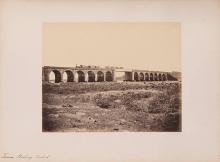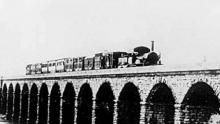The popular image of the India’s first train on a creek bridge shows two Englishmen and an Indian squatting to watch the steam train may not be that of the first train at all. The origin of the image is credited to the British Library item number 254341 with Shelf mark Photo-254/3(41), titled Dapoorie Viaduct [Bombay], and by an unknown photographer dated 1855. “Dapoorie” is however near Pune and a railway bridge having the same number of arches and style of construction does exist on the Mumbai-Pune line called Harris Bridge over the Mula river.
A visit to the site, however, establishes the fact that the Thane creek bridge seen in the popular image is actually not the Thane one, built by George Wythes. Nor is the train seen the first one. The inaugural train, as documented, had three locomotives and fourteen coaches. This image has nine coaches, a coal tender and a single locomotive. Moreover, the photograph is dated 1855, two years after the inaugural run. The construction of Khandala to Pune section was already in progress when the photograph was taken.
It is also important to note that the railway lines between Bombay and Pune could not be extended in a geographical order—Mumbai to Thane by 1853, Thane to Kalyan by 1854 Kalyan to Palasdhari by 1856 and Khandala to Pune by 1858. The Palasdhari to Khandala, the mountain range section was opened only in 1863. Daporiee was also the location of the Governor’s mansion. The Bombay Times report dated May 17, 1858, documenting the opening of the Khandala-Pune section, states that the mansion stood boldly among surrounding villages, indicating that Daporiee was an important location. The same report also mentions that the inaugural party during the return journey inspected the viaduct near Kirkee, opposite to Holkar’s bridge, “a structure of extreme solidity”.
The bridge in the “first train” image is most probably the Harris bridge, but versions do differ. Let’s now come to the Thane viaduct. Construction report of the original bridge in Berkely’s minutes states that the “viaduct over the Tannah estuary has been carried on masonry arches of 30 feet span, divided one portion consisting of nine arches another of 14 and between the two is an iron girder opening of 84 feet span.”
This means that the original bridge was in two parts with a 84-feet opening filled up by an iron girder. Today, the creek bridge has six lines; the oldest are the up and down slow lines. The original bridge is being flanked by bridges on either side with the construction of 5th and 6th lines, next to the original bridge in the west. Starting from Thane station end, walking towards the Parsik Hill, the first stone bridge has nine arches. Under the first two arches, passes a road that connects Thane west to east.
After this bridge, the lines continue for some distance on the raised ground (where the original iron girder stood), now filled up and then there is the second bridge. It has six arches at south Thane end, a steel bridge and seven arches on the north Kayan end, making a total of 13 arches, one less than the Wythes’ original bridge. This all means that the original bridge built by Wythes is still in place in much altered form over the last 160 years and that the popular photograph of the first train may neither actually be of the first run nor of the Thane creek bridge. (The actual image of a train on the first Thane bridge, taken between 1855 and 1862, is attached with this article)
(Excerpted from Halt Station India- The Dramatic Tale of the Nation’s First Rial Lines, Rupa, 2014 by author)


